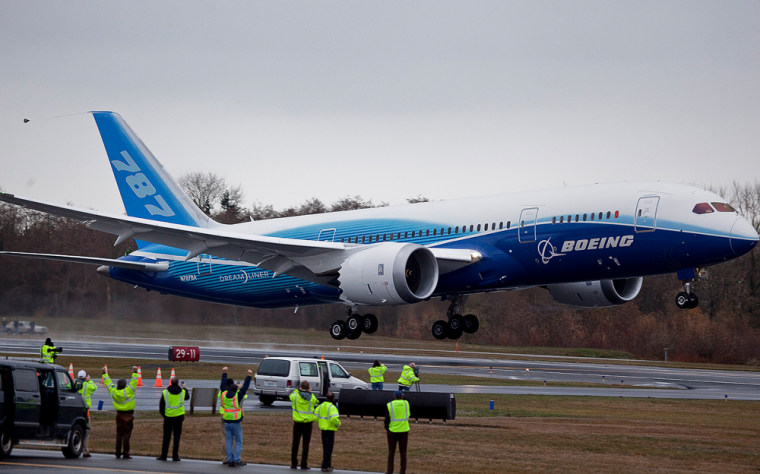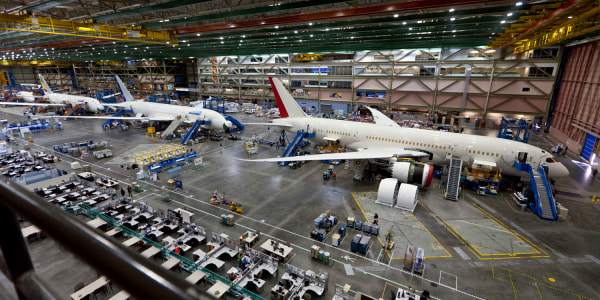Boeing's new 787 jetliner finally got airborne Tuesday, the long-delayed inaugural flight of the world's first commercial plane mostly built from lightweight composite materials.
The sleek jet lifted off from Everett's Paine Field on a flight over Washington state, beginning an extensive testing program needed to obtain Federal Aviation Administration certification.
"It's very historical. I can't think of a thing about it that I'm not impressed with," said Joe Bierce, a flight instructor for Delta Connection in Jacksonville, Florida, who was among the 25,000 people who gathered to watch the takeoff.
The two-member crew performed a variety of basic system checks, including testing the landing gear and the flaps, before landing at Seattle's Boeing Field about three hours later. Deteriorating weather brought the plane back to earth about an hour earlier than planned.
"The airplane responded just as we expected," said Randy Neville, one of the two pilots. "It was a joy to fly."
Before takeoff, the aircraft paused for several minutes at the end of the runway while warming up its engines, adding to the tension for Boeing employees, customers and airline executives standing on the tarmac.
Although the runway was lined with fire trucks and other emergency vehicles, the first flight looked like a normal takeoff as the huge aircraft kicked up clouds of mist.
The plane is the first of six 787s Boeing will use in the nine-month flight-test program that will subject the planes to conditions well beyond those found in normal airline service, including temperature extremes, flying on one engine and slamming on the brakes at takeoff speed.
Chicago-based Boeing, which has orders for 840 of the jets, plans to make the first delivery to Japan's All Nippon Airways late next year.
The 787 is a radical departure in aircraft design. Where other passenger jets are made mostly from aluminum and titanium, nearly all of the 787's fuselage and wings are made of lightweight composite materials such as carbon fiber, accounting for about 50 percent of the aircraft by weight.
Those materials have long been used on individual parts such as rudders, and on military planes, but the 787 is the most ambitious use of the technology aboard a passenger plane.
Boeing says the aircraft will be quieter, produce lower emissions and use 20 percent less fuel than comparable planes, while giving passengers a more comfortable cabin with better air quality and larger windows.
Officials cut the flight a little short after rain reduced visibility at Boeing Field and the aircraft ran into poor weather off the Washington coast.
Pilot Mike Carriker said there was a "very, very aggressive plan" for testing the jet on its initial flight and the crew was able to accomplish about half those goals before coming in. The weather, he said, prevented them from flying the long straight stretches they expected, but did allow them to test the plane in turbulence and icing, things not normally encountered on a first flight.
"There were no major issues with the plane, which considering the complexity is a huge statement," he said.
Boeing has relied on suppliers to build huge sections of the plane that are later assembled in Everett. But that approach so far has proved problematic, with ill-fitting parts and other glitches hampering production.
The first flight was supposed to be in 2007, with deliveries the following year. Boeing was forced to push that back five times — delays that have cost the company credibility, sales and billions of dollars.
Most recently, Boeing needed to reinforce the area where the wings join the fuselage. Tests were completed on that fix just two weeks ago.
An eight-week strike last year by Seattle-area production workers also caused problems and factored in Boeing's decision in October to create a second 787 assembly line in North Charleston, South Carolina.
Scott Fancher, vice president and general manager of the 787 program, said he feels "very comfortable about the timeline" for the 200-day light test program and that 787 production was ramping up "exactly as we planned." The next test flight for the first 787 is expected in about a week, Carriker said.
The 787 remains Boeing's best-selling new plane to date, though some airlines have been forced to cancel or postpone purchase plans because of the weak global economy.
The version being tested will be able to fly up to 250 passengers about 9,000 miles (14,485 kilometers). A stretch version will be capable of carrying 290 passengers and a short-range model up to 330.
Boeing rival Airbus has developed the A350 XWB as the main competitor to the 787 line. Like Boeing's jetliner, the Airbus plane also features composite materials, including in the fuselage and wings.
Slideshow 24 photos
Boeing rolls out 787
According to its Web site, Airbus has received 505 orders for the A350 from 32 customers as of November.
Tuesday's flight "was a very mundane on takeoff and very mundane on the landing, and that's exactly what you want on the first flight of an experimental airplane," said analyst Scott Hamilton of Leeham Co., an aviation consulting firm in Issaquah, east of Seattle. "Boring is good in aviation."
But the importance of the maiden flight, he said, lies in the 787's cutting-edge design and the way it's being manufactured.
"All of this is going to set the stage for all Boeing planes in the future," Hamilton said. "It's a very important milestone in the history of the company."

